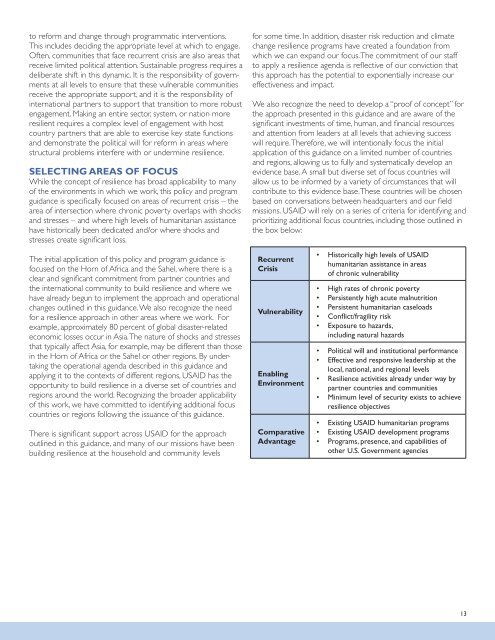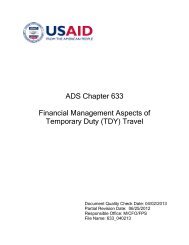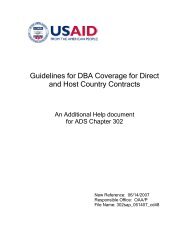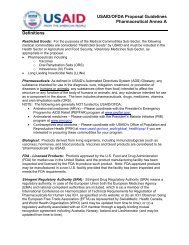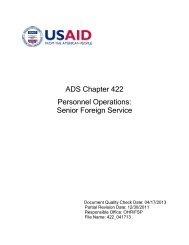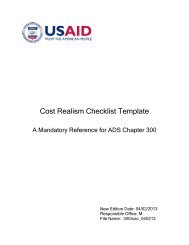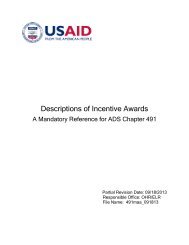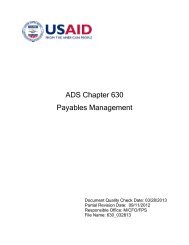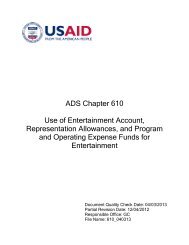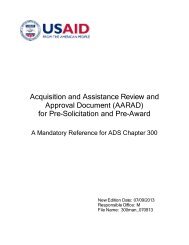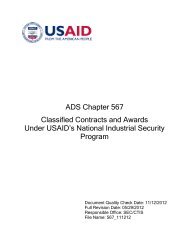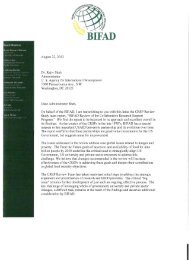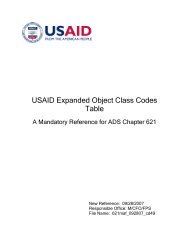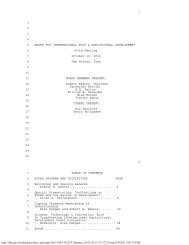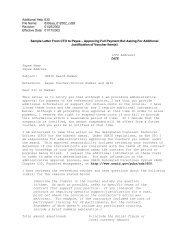USAID Policy Document - Resiliency FINAL 11-26-12.indd
USAID Policy Document - Resiliency FINAL 11-26-12.indd
USAID Policy Document - Resiliency FINAL 11-26-12.indd
- No tags were found...
Create successful ePaper yourself
Turn your PDF publications into a flip-book with our unique Google optimized e-Paper software.
to reform and change through programmatic interventions.This includes deciding the appropriate level at which to engage.Often, communities that face recurrent crisis are also areas thatreceive limited political attention. Sustainable progress requires adeliberate shift in this dynamic. It is the responsibility of governmentsat all levels to ensure that these vulnerable communitiesreceive the appropriate support, and it is the responsibility ofinternational partners to support that transition to more robustengagement. Making an entire sector, system, or nation moreresilient requires a complex level of engagement with hostcountry partners that are able to exercise key state functionsand demonstrate the political will for reform in areas wherestructural problems interfere with or undermine resilience.SELECTING AREAS OF FOCUSWhile the concept of resilience has broad applicability to manyof the environments in which we work, this policy and programguidance is specifi cally focused on areas of recurrent crisis – thearea of intersection where chronic poverty overlaps with shocksand stresses – and where high levels of humanitarian assistancehave historically been dedicated and/or where shocks andstresses create signifi cant loss.The initial application of this policy and program guidance isfocused on the Horn of Africa and the Sahel, where there is aclear and signifi cant commitment from partner countries andthe international community to build resilience and where wehave already begun to implement the approach and operationalchanges outlined in this guidance. We also recognize the needfor a resilience approach in other areas where we work. Forexample, approximately 80 percent of global disaster-relatedeconomic losses occur in Asia. The nature of shocks and stressesthat typically affect Asia, for example, may be different than thosein the Horn of Africa or the Sahel or other regions. By undertakingthe operational agenda described in this guidance andapplying it to the contexts of different regions, <strong>USAID</strong> has theopportunity to build resilience in a diverse set of countries andregions around the world. Recognizing the broader applicabilityof this work, we have committed to identifying additional focuscountries or regions following the issuance of this guidance.There is signifi cant support across <strong>USAID</strong> for the approachoutlined in this guidance, and many of our missions have beenbuilding resilience at the household and community levelsfor some time. In addition, disaster risk reduction and climatechange resilience programs have created a foundation fromwhich we can expand our focus. The commitment of our staffto apply a resilience agenda is refl ective of our conviction thatthis approach has the potential to exponentially increase oureffectiveness and impact.We also recognize the need to develop a “proof of concept” forthe approach presented in this guidance and are aware of thesignifi cant investments of time, human, and fi nancial resourcesand attention from leaders at all levels that achieving successwill require. Therefore, we will intentionally focus the initialapplication of this guidance on a limited number of countriesand regions, allowing us to fully and systematically develop anevidence base. A small but diverse set of focus countries willallow us to be informed by a variety of circumstances that willcontribute to this evidence base. These countries will be chosenbased on conversations between headquarters and our fi eldmissions. <strong>USAID</strong> will rely on a series of criteria for identifying andprioritizing additional focus countries, including those outlined inthe box below:RecurrentCrisisVulnerabilityEnablingEnvironmentComparativeAdvantage• Historically high levels of <strong>USAID</strong>humanitarian assistance in areasof chronic vulnerability• High rates of chronic poverty• Persistently high acute malnutrition• Persistent humanitarian caseloads• Confl ict/fragility risk• Exposure to hazards,including natural hazards• Political will and institutional performance• Effective and responsive leadership at thelocal, national, and regional levels• Resilience activities already under way bypartner countries and communities• Minimum level of security exists to achieveresilience objectives• Existing <strong>USAID</strong> humanitarian programs• Existing <strong>USAID</strong> development programs• Programs, presence, and capabilities ofother U.S. Government agencies13


